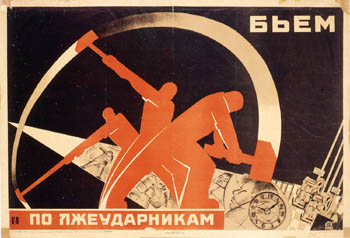![[Metroactive Arts]](/arts/gifs/art468.gif)
[ Arts Index | Silicon Valley | Metroactive Home | Archives ]

Sickle Cycle: A Soviet poster from the 1930s promotes the power of the motivated worker. Wall Art A new show at Stanford surveys the art of political persuasion By Michael S. Gant THE FURIOUS ART of graphic exhortation has fallen on fallow times. No great excoriating poster has captured anti�Iraq war anger, for example, as pointedly as a mock "Bank of Amerika" check imprinted with the image of a B of A building burning down during a protest against the Vietnam war did in 1970. The best remnants of a grand tradition now circulate on the Internet in the form of quick-hit collages of President Bush looking typically clueless. In one, a photo of world leaders on their knees before the red-robed body of Pope John Paul II features a word balloon over Bush's head reading, "What happened to Santa?" More recently, a screen-capture of the president at a post-Katrina press conference includes the bottom-crawl text: "Bush: One of the worst disasters to hit the U.S." Some prime examples of classic image-mongering can be seen at the Cantor Arts Center's latest show, "Revolutionary Tides: The Art of the Political Poster, 1914�1989." A generous selection from the Hoover Institution and the Wolfsonian-Florida International University demonstrates the varied and insidious ways that posters have been used to provoke national unity, promote revolution and demonize enemies, from Bolshevik Russia and beleaguered France in World War I to Nazi Germany and America in World War II to Nicaragua, Poland and Iran in the era of 1970s and '80s rebellion. The most striking posters convey the maximum impact with the least distraction. A 1931 Soviet poster depicts a red-silhouetted, hammer-wielding worker in three freeze-frame moments. The hammer's sickle-shaped trajectory leads to a punishing climax as it strikes the head of a stereotypical trouble-maker. The deep content of the image requires some historical background about so-called "false shock workers" taking advantage of five-year plans in Soviet factories, but the visual impression is overwhelming: the worker smashes a roadblock to socialist progress. You can almost feel the concussion. Red also compels the eye in a 1932 National Socialist poster that commands voters to choose List One (the Nazi party spot on the ballot), represented as a monolithic block numeral mounted on a red swastika into which antlike masses of voters pour. In hindsight, the arms of the swastika look like a maze from which Germans would not emerge for 15 years, but there is no denying the arresting quality of the image—no matter how much we wish it weren't true, bad politics can sometimes make good posters. Other posters, however, look hopelessly overcrowded with both words and pictures. Even if you knew Italian and could read all the fine print in the 1937 fascist banner How One Becomes a Teacher of Physical Education, the effort would probably leave you exhausted rather than inspired. The show achieves some surprising moments in its arrangement of shared graphic techniques used across political boundaries. The same clenched fist at the end of a muscular forearm breaks the chains of Nazi occupation, shatters the chains binding Germans wishing to be united under the Führer and obliterates the chains of capitalist exploitation. That's a lot of work for one fist, even if it is metaphorical. In a related gesture, the hand pounds on tables, flashes the peace sign, clutches at helpless countries or points its finger at people whose loose lips sink ships (as in a famous American war poster called Someone Talked!). To symbolize unity across borders, the fist of one country shakes hands with the fist of another in a coordinated campaign to fight a common enemy. At first, a couple of Andy Warhol silk-screens of Chairman Mao feel like forced irony. These were never meant to function as political statements plastered on a wall. But at second glance, most of the posters in the exhibit, carefully matted on archival board and framed with tasteful blond wood, have become aesthetic objects with the passage of time and ideologies. Yesterday's call to arms has become today's collectible.
Revolutionary Tides shows through Jan. 1 at Cantor Arts Center, Stanford. (650.723.4177)
Send a letter to the editor about this story to letters@metronews.com. [ Silicon Valley | Metroactive Home | Archives ]
|
From the September 21-27, 2005 issue of Metro, Silicon Valley's Weekly Newspaper.
Copyright © 2005 Metro Publishing Inc. Metroactive is affiliated with the Boulevards Network.
For more information about the San Jose/Silicon Valley area, visit sanjose.com.